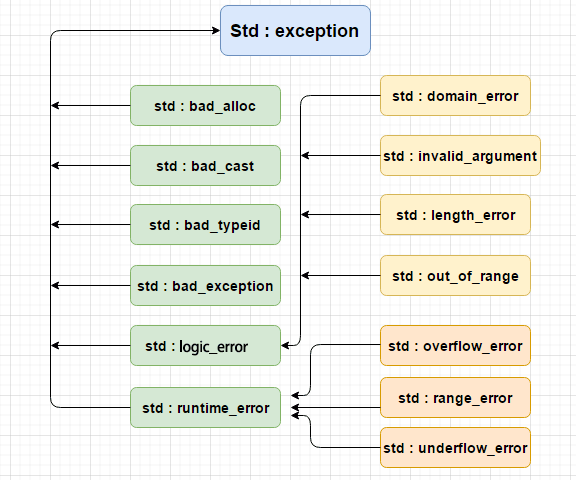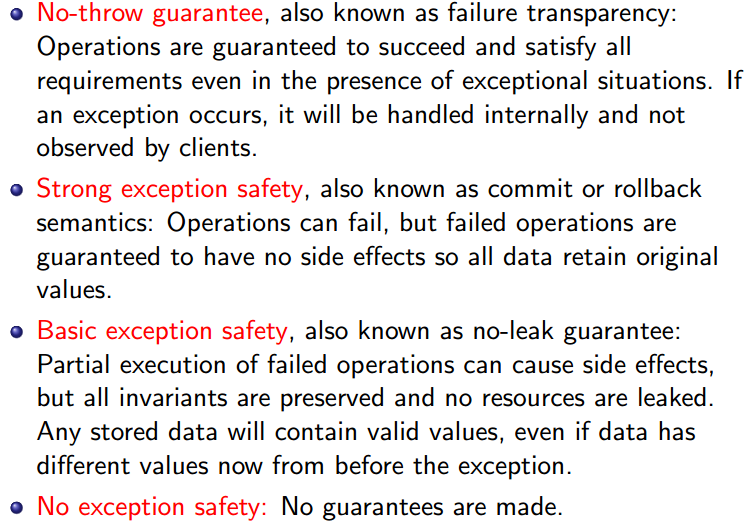[c++] Exceptions
异常处理
一、相关资料
[ 之后,针对本章节、根据链接再进行一次系统的学习 ]
基本结构
try {
throw logic_error{"blah"};
} catch (exception) {
// caught here!
} catch (logic_error) {
// not here!
}
百家讲坛 - "必要性"
[1]
为什么需要异常机制:https://blog.csdn.net/K346K346/java/article/details/50087193
C++之父Bjarne Stroustrup在《The C++ Programming Language》中讲到:
(a) 一个库的作者可以检测出发生了运行时错误,但一般不知道怎样去处理它们(因为和用户具体的应用有关);
(b) 另一方面,库的用户知道怎样处理这些错误,但却无法检查它们何时发生(如果能检测,就可以在用户的代码里处理了,不用留给库去发现)。
Bjarne Stroustrup说:提供异常的基本目的就是为了处理上面的问题。基本思想是:让一个函数在发现了自己无法处理的错误时抛出(throw)一个异常,然后它的(直接或者间接)调用者能够处理这个问题。
[2]
C++ 引入异常的原因之一是:为了能让构造函数报错(析构函数不能抛异常这是大家都知道的常识),毕竟构造函数没有返回值,没有异常的话调用方如何得知对象构造是否成功呢?
[3]
到了异常,一般就直接让本次操作失效,保存状态好了.
定义异常
一、内置 Error类型

下表是对上面层次结构中出现的每个异常的说明:
| 异常 | 描述 |
|---|---|
| std::exception | 该异常是所有标准 C++ 异常的父类。 |
| std::bad_alloc | 该异常可以通过 new 抛出。 |
| std::bad_cast | 该异常可以通过 dynamic_cast 抛出。 |
| std::bad_exception | 这在处理 C++ 程序中无法预期的异常时非常有用。 |
| std::bad_typeid | 该异常可以通过 typeid 抛出。 |
| std::logic_error | 理论上可以通过读取代码来检测到的异常。 |
| - std::domain_error | 当使用了一个无效的数学域时,会抛出该异常。 |
| - std::invalid_argument | 当使用了无效的参数时,会抛出该异常。 |
| - std::length_error | 当创建了太长的 std::string 时,会抛出该异常。 |
| - std::out_of_range | 该异常可以通过方法抛出,例如 std::vector 和 std::bitset<>::operator[]()。 |
| std::runtime_error | 理论上不可以通过读取代码来检测到的异常。 |
| - std::overflow_error | 当发生数学上溢时,会抛出该异常。 |
| - std::range_error | 当尝试存储超出范围的值时,会抛出该异常。 |
| - std::underflow_error | 当发生数学下溢时,会抛出该异常。 |
二、自定义异常类型
通过继承和重载 exception 类来定义新的异常。
#include <iostream> #include <exception>
using namespace std;
// 竟然是个struct struct MyException : public exception { const char* what () const throw { return "C++ Exception"; } };
// -------------------------------------------------
int main() { try { throw MyException(); } catch(MyException& e) { std::cout << "MyException caught" << std::endl; std::cout << e.what() << std::endl; } catch(std::exception& e) { // 其他的错误 } }
类可以继承,结构体也可以继承.
#include <iostream>
using namespace std;
// class MyException : public exception { public: const char* what() const throw () // <---- { std::cout << "my exception" << std::endl; return NULL; } }; void f1(bool flag = true) { if (flag) throw MyException(); } void f2(bool flag = true) throw () { if (flag) throw MyException(); }
----------------------------------------------------- int main(void) { try { f1(); }
catch (...) {
; }
std::cout << "f1()异常将被捕获,不会 abort,将继续执行" << std::endl; try { f2(); }
catch (...) {
; }
std::cout << "f2()异常不会被捕获,程序将会 abort,将不会执行该条语句" << std::endl; return 0; }
使用异常
Catch-by-reference is BETTER
Problems with Catch-by-value:
-
- inefficient due to object copying
- causes the slicing problem, and
- cannot exploit polymorphism and dynamic binding
Catch-by-reference avoids all these problems.
catch的参数是引用,自然就不需要拷贝了。
-
Catch-by-Value
#include <iostream>
using namespace std;
class X {
public:
X() {
std::cout << "X constructed" << std::endl;
}
X(const X &x) {
std::cout << "X copy-constructed" << std::endl;
}
~X() {
std::cout << "X destructed" << std::endl;
}
};
void g() {
throw X{};
}
void f() {
try {
g();
} catch (X x) { // 改为catch(X &x), 其他同理
std::cout << "caught in f; rethrow" << std::endl;
throw;
}
}
int main()
{
cout << "Hello World!" << endl;
try {
f();
} catch (X x) { // 这里又是一次 浪费时间的 copy
std::cout << "caught in main" << std::endl;
}
return 0;
}
Result:

-
Catch-by-Reference
改为reference后,concise了不少!

-
Stack Unwinding

关于new object这件事上,Obversely, this avoids memory leaks but is messy.
便有了Smart Pointer? 这里是初始化列表的用法。

Stack Exception Safety
如果noexcept修饰的函数抛出了异常,编译器可以选择直接调用std::terminate()函数来终止程序的运行,这比基于异常机制的throw()在效率上会高一些。
这是因为异常机制会带来一些额外开销,比如函数抛出异常,会导致函数栈被依次地展开(unwind),并依帧调用在本帧中已构造的自动变量的析构函数等。
Common Levels of Exception Safety

End.



